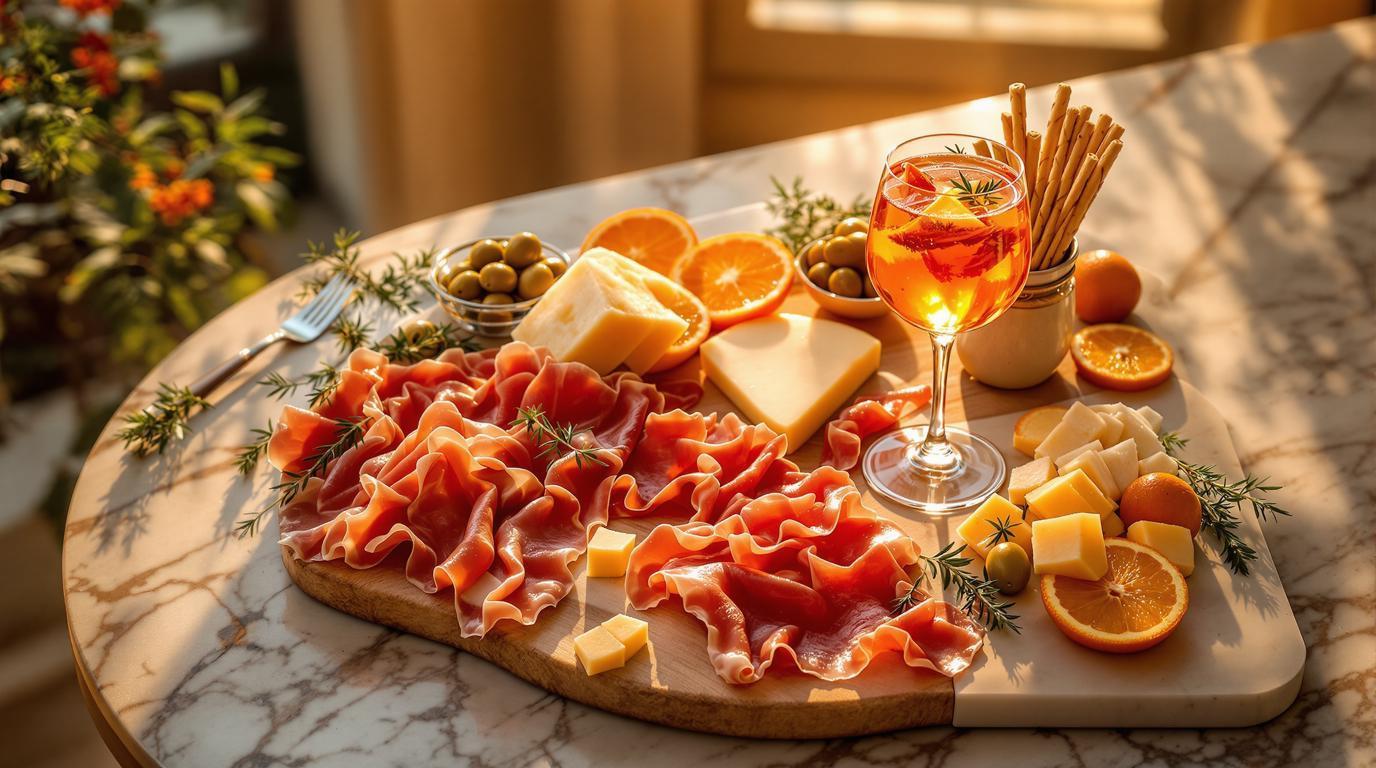There’s something magical about the Italian aperitivo hour – that golden moment when the workday ends and pleasure begins. I first experienced this ritual in Venice, where locals gathered along canal-side cafés, Aperol Spritzes glowing orange in the late afternoon sun. What struck me wasn’t just the vibrant drinks but the boards of perfectly curated bites accompanying them. Today, I’m sharing my perfected Aperol Spritz Board that transports me back to those Venetian evenings every time I serve it. The beauty lies in its simplicity – quality ingredients arranged with care, requiring no cooking but delivering maximum impact. 🇮🇹
The Art of Italian Aperitivo 🍊
The Aperol Spritz originated in Northern Italy’s Veneto region, where it evolved from the Austrian tradition of adding a splash (spritz) of water to wine. After World War II, the distinctive bitter-orange Aperol liqueur became the star ingredient, creating the sunset-colored cocktail we know today. But a proper Aperol Spritz is never served alone – it’s accompanied by stuzzichini (small bites) that stimulate conversation as much as appetite.
Chef’s Note: The secret to an authentic aperitivo board isn’t complexity but quality. Choose fewer, better ingredients rather than overcrowding your board. This respects the Italian philosophy of la dolce far niente – the sweetness of doing nothing – allowing you to focus on the company rather than fussy food.
Perfect Spritz Formula 🥂
Before assembling your board, master the iconic cocktail at its center. The classic ratio is 3-2-1:
- 3 parts Prosecco (dry, not extra dry)
- 2 parts Aperol
- 1 part soda water
- Orange slice
- Ice cubes
Pour over ice in a large wine glass, stir gently, and garnish with an orange slice. The result should be effervescent, slightly bitter, and refreshingly bright – the perfect companion to savory bites.
Curating Your Board 🧀
The ideal Spritz board balances savory, salty, and slightly sweet elements while maintaining visual appeal. For four guests, include:
- Salumi Selection (150g): Thinly sliced prosciutto di Parma (folded, not flat), Salami Milano, and mortadella if desired. Room temperature brings out the full flavor.
- Cheese Varieties (200g): Contrast textures with chunks of aged Parmigiano-Reggiano and creamy fresh mozzarella or bocconcini. In summer, I sometimes add a small bowl of whipped ricotta drizzled with olive oil and cracked pepper.
- Marinated Vegetables (1-2 cups): Quality olives (I prefer plump Castelvetrano), artichoke hearts, and roasted red peppers provide acidic contrast. Serve these in small bowls to contain their marinade.
- Bread Elements: Grissini breadsticks standing upright in a glass and crostini slices create textural interest and vehicles for softer items.
- Fresh Accents: Orange slices echo the garnish in your Spritz, while green apple slices and small grape clusters provide refreshing breaks between richer bites.
Assembly Technique 🎨
Composition matters in an aperitivo board. I start by placing my small bowls of olives and marinated items first, creating anchors around which I arrange other elements. Meats should be loosely folded, not flat, creating height and air pockets that enhance texture. Cheeses are best chunked rather than sliced for an inviting, rustic feel.
Remember that Italians eat with their eyes first – use fresh herbs like rosemary sprigs or basil leaves as natural garnishes that add aromatic elements. A small bowl of roasted, salted almonds provides a satisfying crunch between sips of your Spritz.
Seasonal Adaptations 🌿
While maintaining tradition, I adjust my board seasonally. In summer, I might add Italian-inspired avocado boats for creaminess. Fall boards welcome fig quarters drizzled with honey. Winter calls for a small dish of warming matcha latte alongside. Spring brings tender asparagus spears wrapped in prosciutto.
For guests who prefer something heartier, consider adding grilled halloumi cubes or prepare individual layered charcuterie jars for a modern twist on tradition.
Chef’s Substitution: No Aperol? While not traditional, Campari makes a more intensely bitter Spritz, or Select (another Venetian aperitif) offers a slightly different flavor profile. For a non-alcoholic version, mix Sanbitter or Crodino with soda water and orange slices.
The beauty of the aperitivo ritual isn’t just in the flavors but in the permission it gives us to pause, connect, and savor. As you raise your Spritz among friends with a simple “Cin cin!” remember that you’re participating in one of Italy’s most beloved traditions – a moment of simple pleasure in a busy world. And if you’re looking for a sweet finish, my 3-ingredient frozen banana bites make the perfect light dessert that won’t overwhelm the experience. Salute! 🥂
